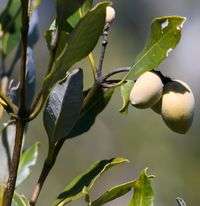Hanging on? Credit: Bob Beale
(PhysOrg.com) -- Climate change this century is expected to place substantial strain on the integrity and survival of some of the world's biologically important conservation regions, with most experiencing monthly climate conditions that were considered extreme in the recent past, says a new study.
Within the next 60 years, almost all of the Global 200 "ecoregions" – those selected for priority conservation for their irreplaceability or distinctiveness - will experience extreme monthly temperatures with a local warming of up to 2 °C, the study has found.
Tropical and subtropical ecoregions - including some in northern Australia - and mangroves face extreme conditions earliest, with those in Africa and South America thought to be particularly vulnerable to even relatively small temperature increases, according to a report in the journal Proceedings of the National Academy of Sciences.
The study team, led by Dr. Linda Beaumont of Macquarie University, includes UNSW's Professor Andy Pitman, Director of the ARC Centre of Excellence for
Climate System Science.
Mangrove: sensitive to heat stress. Credit: Bob Beale
They found that Amazon rainforests are vulnerable to reduced rainfall and higher temperatures but, in contrast, few ecoregions within boreal forests and tundra biomes will experience such extremes this century.
The study used actual climate records between 1961 and 1990 as a baseline and looked at projections of climate change through to 2070.
"Biodiversity and the maintenance of associated ecosystem goods and services are vital for human well-being, yet despite increases in conservation activity, the loss of biodiversity continues," the report says.
"Although habitat degradation, fragmentation and destruction, over-exploitation and invasive species have driven recent biodiversity loss, climate change is projected to be a major driver of extinction throughout the 21st century, both directly and via synergies with other stressors."
Ultimately, the ability of species and ecosystems to respond positively to climate change will depend on the capacity of species to rapidly adapt or to disperse to other habitats and the natural resilience of biological systems to such changes, it says. But those responses will also depend on pressures due to human activity and the extent to which future climate regimes present conditions beyond those previously experienced.
Deforestation of mangroves is occurring at a rate of 1 to 2% a year, for example, with sea-level rises threatening up to 15% of the world's mangroves this century: but the study found that mangroves require only a small rise in local temperatures of less than 1.3 °C for monthly climatic conditions to become extreme and expose the trees to heat stress.
"The sustainability and protection of the Global 200 would be of immense value to conservation efforts worldwide because of their richness in endemic species, high taxonomic uniqueness, unique ecological or evolutionary phenomena, global rarity and their representation of biomes.
"Most of them, however, are already threatened by habitat loss, fragmentation and degradation, with 147 of 185 terrestrial and freshwater regions being classified as either vulnerable or critically endangered.
"Exposure of these ecoregions to significant climate change—in particular, extreme or novel conditions—will further undermine efforts to protect them. The identification of those ecoregions that in the future may commonly experience climate patterns that would be considered 'extreme' could lead to reprioritization of conservation efforts."
Provided by University of New South Wales






















